
To understand the complex cosmology of our actual universe, we have to use the tools given to us with which to measure: we have to make study of numbers, and not in a traditional sense, as facts and figures of weights and measures, of distance and duration. Instead, we must look at certain groupings that combine certain quantitites of objects or ideas. For example, we must make use of the ten sefirot emanations upon the "tree of life." So far, we have studied mainly the systems of seven and twelve, but now I mean to talk about the base ten as well.
But first let me readumbrate the base seven system. Here is how it evolved: it begins with a torus viewed from above at a forty-five degree angle. The torus is a doughnut-shaped object, and the number seven takes to it naturally in the form of its being the minimum number of surfaces that can be mapped onto the doughnut-shaped form of the torus. This is known as the "seven colour" mapping problem. The result of maping seven such contiguous areas onto the doughnut shape is a peculiar kind of spiral. We can use this spiral to measure the surface of the torus. I call this spiral "phi/pi."

Here, however, we see seven applied to the torus at 45° as a means of solving a minimum packing-space arrangement using circles to depict spheres. Generally these 7 "spheres" were associated with the seven visible planets, including the sun and moon, however, as I have already demonstrated, creating a phi spiral using the Pythagorean theorem to "square the circle" and constructing a model in 3-space from the flat, 2-D pattern, are both well documented methods of rendering that make use of the base seven system. Here it has been applied in the form of the minimum number of equal sized objects that can be packed into a torus at a 45° angle.
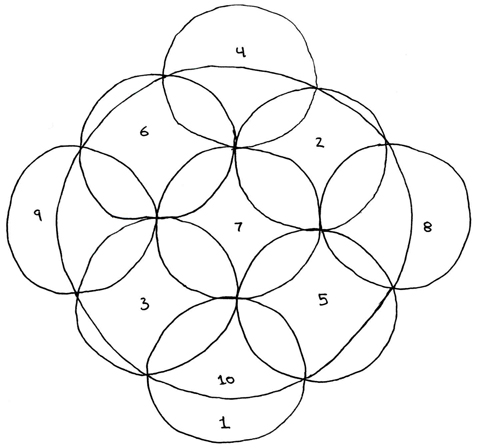
Now, let us introduce the idea of the ten sefirot emanations of the "tree of life" (the hypercube at antipode). If we take the torus at 45° and we turn it such that we are looking down the pole of its central hole, then the minimum number of spheres drawn as circles that can be packed into the shape of the torus would be ten. These are the ten sefirot emanations. In the Sefer Yetzirah, the Book of Formation, it describes these ten as like two clasped hands, each of four "fingers" and a central, "thumb," ring for each.
In the same way the ten sefirot emanations are here arranged in their minimum equal-sized packing array, so too is their ordering here devised as a string wrapped over, under, around and through the centre of the torus. From the tenth it connects back to the first. This sequence is meant, for the base ten array to plot the same form of phi/pii spiral as can be demonstrated with the torus for the base seven set. In the same way the phi/pi spiral defines the base seven torus, so does this sequence display the same measurement for the base ten torus.
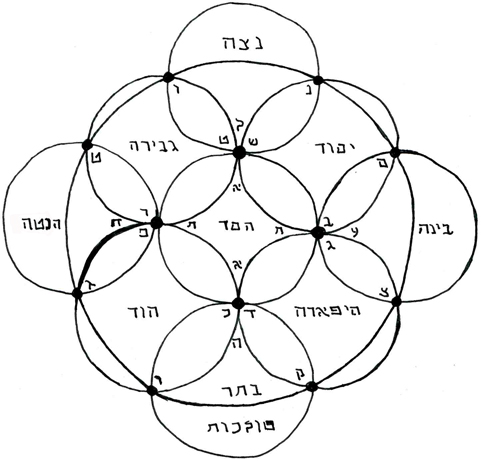
Here is the "tree of life" diagram of ha QBLH expressed as the minimum number of spheres that can be packed to form a torus at 90°. What is special about this arrangement is that the number of points of intersection are equal to the number of "paths" (edges) on the "tree of life" (hypercube at antipode): 22. 22 is special because it is the number of letters in the Hebrew alphabet. In the Hebrew alphabet, each letter also represents an element, a planet or a constellation. There are twelve constellation letters, equivalent to the twelve consonants in Greek. There are seven planetary letters equivalent to Greek vowels. The three remaining letters, aleph (A), mem (M), and shin (S), are equivalent to Alchemical salt, sulpher and mercury, that is, combinations between the four elements. Each of the sefirot is gven its name in Hebrew. Below is Malkuth. The greater circle that connects and contains all the others, depicting a torus, is Kether.
Having now talked about the base 7 and base 10 torus shapes (at 45° and 90°), there is still one more method of this kind we can discuss (at zero or 180°). This is actually the most important method of measuring for our universe's cosmology; there are far more attributes associated with the base 12 system than both the base 7 and base 10 systems combined. Here we see the minimum packing ratio for only the ecternal ring of the torus, excluding the area of the central sphere (the hole of the doughnut). Each zodiac sign is accorded a tribe in Hebrew and an apostle of Jesus in Greek.
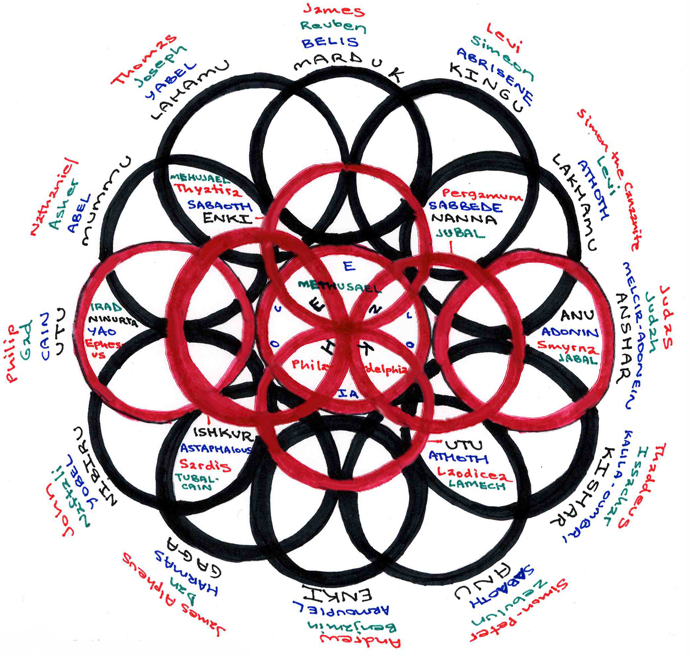
Here is a combination of the base 12 and base 7 systems as minimum packaging-space problems. Because the base 7 and base 12 systems have been in use since the most ancient known antiquity, there is no short supply of corresponent attributes, and only a select few have been listed here. The key for decoding them is given thus:

The reason for discussing the base 7 and 12 systems in particular is that they are considered the basic cosmological number sets of measuring attributes for studying our universe's original and current cosmology. The base 10 system is considered an addition to the basic seven of three "supernal" sefirot, considered more psychological in nature. However, though the 7 and 12 combination is more well known, we must study the combination, absent in the base 12 system, of the central sphere's overlaps. In the base 10 system we observe four outer spheres overlapping the central sphere. Likewise, in the base seven system, four overlap the central sphere.
It is in this central sphere we must look to find the engine of our universe's creation, the event that caused the "big bang." In order to see why the base 10 "tree of life" (hypercube at antipode) would factor in to the moment of our universe's very creation, let me show you some diagrams that are more to do with physics and cosmology than symbolism and mythology.

In this image, we see the base 7 (green), 10 (black) and 12 (red) systems inside a blue lattice. This blue lattice of lines and squares represents the geometry of the circles and spheres. The placement of everything remains the same, except for the base 12 system, shown as an ellipse seen at zero or 180° (flat-on), instead of as the minimum packing-space problem.
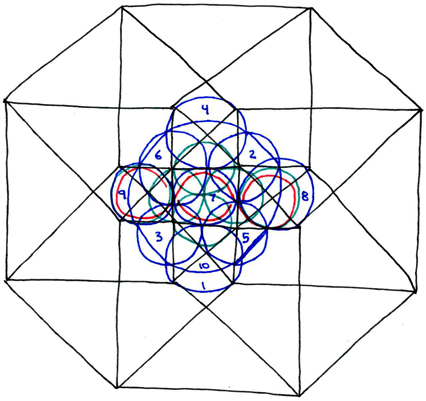
In order to study the core of our existence it is necessary to go outside of the local universe, through the multiverse, await the nulliverse, and only then by luck witness the random quantum fluctuation producing matter from anti-matter that precipitates the "big bang" at the moment of the universe's creation. This overlapping of the basic, geometric number systems with the cosmological model of universal physics (at this stage still only visualised as a light-cone), is essential to understanding both. in the central origin-point of the first baby universe inside a black hole's gravitational singularity, the "ten" come together with the "seven" in a complex confluence of forces.
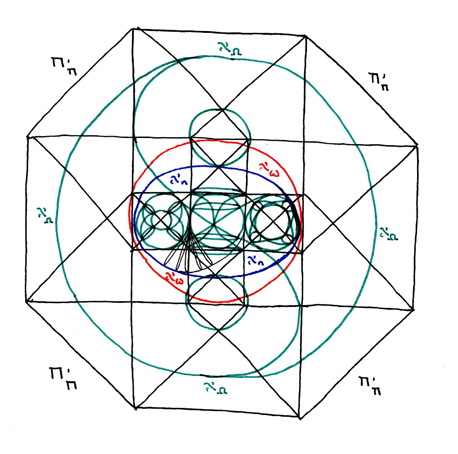
The colour coding of this diagram is the same as for tau sub tau. The green signs of the zodiac here represent the same depth as the green aleph sub omega yin-yang of the tau sub tau diagram. Here, the red seven "planets" are equivalent there to the red aleph sub sigma circle, or inner-sphere of the green torus. Likewise, the blue toroid of aleph sub n, representing the singularity inside the black hole the event horizon of which is the green, outer-sphere, aleph sub omega, is equivalent to the ten sefirot array (the minimum packing space for a hypersphere at antipode).

Now, let us look at the central sphere, depicted as a circle in the above diagram, and let us study how the base seven and base ten systems (or the aleph sub sigma hypersphere and aleph sub n torus) interact as an engine of creation central to Tau sub Tau.

In this diagram, the blue lines indicate the shape of the doughnut seen from above its hole. The red spirals are channeling inward to the central point, and the green grid, or Cartesian coordinate square shaped plane, is pulled off toward four singularities at the base of the red spirals, and is collapsed at the centre by their conflux.
The red spirals signify the aleph sub sigma hypersphere's contribution to our universe's creation. The aleph sub sigma hypersphere represents the wormholes inside the aleph sub omega black hole's event horizon. Beyond aleph sub omega is our parent universe.
The green grid represents the raw material taken from the surrounding space of our parent universe into the aleph sub omega black hole, converted through the aleph sub sigma wormholes inside the event horizon, and then contributed into our universe's parent singularity, the aleph sub n toroid. The grid is thus "saddle-shaped" because it is an open geometry, the opposte of a closed geometry, such as the surface of a sphere.
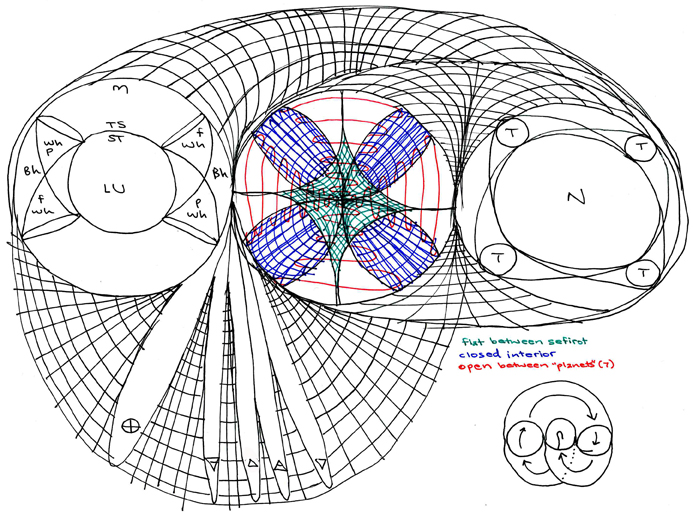
This diagram depicts the tau sub tau diagram seen from a 90° angle from its standard position depiction as a tesseract. Here we see the formation of the universe (the light-cone history) extends back from the left circle (representing the present local universe surrouded by the multiverse) back in time to the point of singularity at the origin of the central circle (representing the engine of creation). On the right is the nulliverse, formed from a perpendicular twist between our present universe and the lightcone of its past history. Likewise a second twist occurs in the engine of creation as it warps the natural trajectory of the nulliverse around and inward toward itself as the singularity's core.
In the next section I will delve more deeply into the geometry of the engine of creation, the central sphere where the base seven and the base ten sets overlap.
-ben
-------------------------------------------------------------------------------
this information is all © 2007 Jonathan Barlow Gee
LINKS: